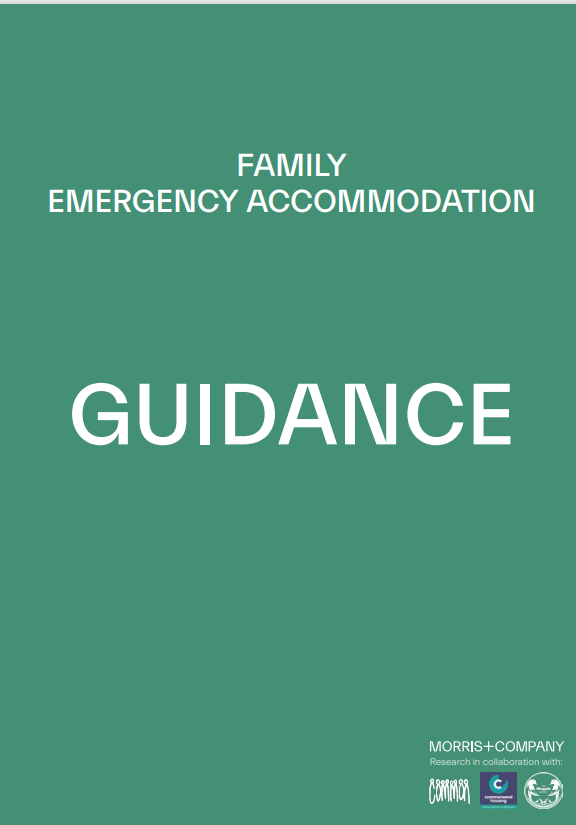
Unsafe and unsuitable standards for families in emergency accommodation, new report shows
A new report by London-based architects Morris+Company, funded by Commonweal Housing, outlines guidance to improve spatial and design standards for emergency accommodation for families with dependent children.
The ‘Families in Emergency Accommodation Guidance’ also in collaboration with developers Common Projects and The Magpie Project – a charity supporting mothers and young children in temporary accommodation – was produced through policy mapping and face-to-face interviews, which evidence the critical need for better standards in emergency accommodation for families.
The research shows there is currently no specific regulatory framework that provides design guidance or space standards for emergency accommodation for families with infant children, which has led to a disparity in the spaces used for emergency accommodation and the quality of the provision available for families in need.
Some local authorities provide additional Houses in Multiple Occupancy (HMO) guidance beyond the standards included in the Housing Act. However, this is often inconsistent and rarely considers infants and children under ten as requiring suitable space.
The Housing Act sets out a standard requirement of 90 sqft (8.3 sqm) for one and a half persons for a single bedroom (single-person occupancy), while infants under the age of one are unaccounted. Therefore, a mother with multiple children under one could lawfully be placed in a single bedroom that cannot accommodate furniture for safe sleeping, adequate storage, window/door access or space for a pram.
The report demonstrates the lack of spatial and environmental standards definitively impacts the mental health, physical health, educational and economic prospects of children and families in emergency accommodation. Parallels between poor quality accommodation and increased child mortality were also drawn, with at least 200 individual records of child deaths where homelessness or living in temporary housing were present found between April 2019 and March 2022, according to the National Child Mortality Database (NCMD).
In the first quarter of 2023, 131,370 dependent children were living in emergency and temporary accommodation. Despite the significant demand for emergency accommodation for families, local authorities are not required to consider the need for emergency accommodation in their local plans – an outline of local authorities’ vision and framework for the future development of their community – often due to a lack of communication between local authority homeless and planning teams.
Within local plans policy key differences between emergency, temporary and permanent housing are also rarely distinguished. As such, it is often unclear to local authorities which planning guidance is relevant to the distinct forms of accommodation. The report also found the use of umbrella terms such as ‘temporary housing’ and ‘temporary accommodation’ means that something as pressing as the need for purpose-built emergency accommodation (PBEA) is overlooked in local plans.
To help inform local authorities’ emerging planning policy and decision-making, Morris+Company utilised the report’s findings alongside local authority housing specialists and industry professionals to define a set of recommendations, spatial guidance and standards associated with family emergency accommodation.
The guidance offers a suggested insertion for local authorities’ local plans to instigate purpose-built or purpose-retrofitted emergency accommodation subjected to space standards:
- Councils must highlight the need for emergency accommodation in their local plans to encourage the development of purpose-built stock.
- New funding models need to be supported to enable local authorities to meet the needs of their community.
- The spatial and design guidance for emergency accommodation laid out in the report, such as private space and proximity to outdoor play areas and schools, to be endorsed by local authorities and referred to in local plans to streamline delivery and improve standards.
The report is also calling for a new, more specific definition of emergency accommodation to denote places where people are housed for 56 days while local authorities carry out a duty of care assessment, alongside more social and truly affordable housing to be built so long-term forms of temporary accommodation can be phased out or aligned to general housing standards.
Ashley Horsey, Chief Executive at Commonweal Housing, said: “With the number of families with dependent children in need of emergency housing rapidly growing, it’s vital the standards within this accommodation are urgently adapted to provide a safe and secure living environment for children and families. Commonweal is pleased to have supported Morris+Company with funding to produce spatial and design guidance to help local authorities improve the conditions for families in emergency accommodation.”
